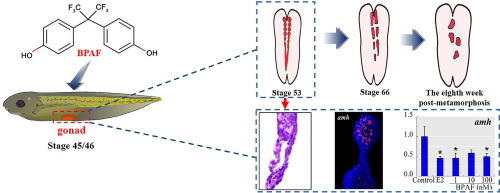Environmental Pollution ( IF 7.6 ) Pub Date : 2020-01-13 , DOI: 10.1016/j.envpol.2020.113980 Man Cai 1 , Yuan-Yuan Li 1 , Min Zhu 1 , Jin-Bo Li 1 , Zhan-Fen Qin 1

|
Developmental exposures to estrogenic chemicals possibly cause structural and functional abnormalities of reproductive organs in vertebrates. Bisphenol AF (BPAF), a bisphenol A (BPA) analogue, has been shown to have higher estrogenic activity than BPA, but little is known about the effects of BPAF on gonadal development, particularly gonadal differentiation. We aimed to determine whether low concentrations of BPAF could disrupt gonadal differentiation and subsequent development using Xenopus laevis, a model species for studying feminizing effects of estrogenic chemicals. X. laevis tadpoles were exposed to BPAF (1, 10, 100 nM) or 17β-estradiol (E2, positive control) from stages 45/46 to 53 and 66 in a semi-static exposure system, with a prolonged treatment with the highest concentration to the eighth week post-metamorphosis (WPM8). Gonadal morphology and histology as well as sexually dimorphic gene expression were examined to evaluate the effects of BPAF. All concentrations of BPAF caused changes in testicular morphology at different developmental stages compared with controls. Specifically, at stage 53, BPAF like E2 resulted in decreases in both the size and the number of gonadal metameres (gonomeres) in testes, looking like ovaries. Some of BPAF-treated testes remained segmented and even became discontinuous and fragmented at subsequent stages. Histological abnormalities were also observed in BPAF-treated testes, such as ovarian cavity at stages 53 and 66 and poorly developed seminiferous tubules on WPM8. At the molecular level, BPAF inhibited expression of male highly expressed genes in testes at stage 53. Correspondingly, BPAF, like E2, inhibited cell proliferation in testes at stage 50. All results show that low concentrations of BPAF inhibited testicular differentiation and subsequent development in X. laevis, along with feminizing effects to some degree. Our finding implies a risk of BPAF to the male reproductive system of vertebrates including humans.
中文翻译:

使用非洲爪蟾模型评估低浓度双酚AF对性腺发育的影响:发现睾丸分化抑制与女性化相结合。
发育过程中暴露于雌激素化学物质可能会导致脊椎动物生殖器官的结构和功能异常。已显示双酚A(BPA)类似物双酚AF(BPAF)具有比BPA更高的雌激素活性,但对BPAF对性腺发育特别是性腺分化的影响知之甚少。我们的目的是使用非洲爪蟾(Xenopus laevis)(一种研究雌激素化学物质女性化作用的模型物种)来确定低浓度的BPAF是否会破坏性腺分化和随后的发育。X. laevis t暴露于BPAF(1、10、100 nM)或17β-在半静态暴露系统中从45/46阶段到53和66阶段的雌二醇(E2,阳性对照),以最高浓度延长治疗至变态后第八周(WPM8)。检查性腺的形态和组织学,以及性二态性基因表达,以评估BPAF的作用。与对照组相比,所有浓度的BPAF都会在不同的发育阶段引起睾丸形态的变化。具体来说,在第53阶段,BPAF像E2一样导致睾丸中性腺metamere(性腺)的大小和数量都减少,看起来像卵巢。某些经BPAF处理的睾丸仍保持分段状态,甚至在后续阶段变得不连续且破碎。在经BPAF处理的睾丸中也观察到组织学异常,例如在53和66期的卵巢腔,以及WPM8上的生精小管发育不佳。在分子水平上,BPAF在第53阶段抑制雄性高表达基因的表达。相应地,BPAF与E2一样在第50阶段抑制了睾丸中的细胞增殖。所有结果表明,低浓度的BPAF抑制了睾丸的分化和随后的发育。X. laevis,在某种程度上具有女性化的效果。我们的发现暗示对包括人类在内的脊椎动物的雄性生殖系统有BPAF风险。











































 京公网安备 11010802027423号
京公网安备 11010802027423号